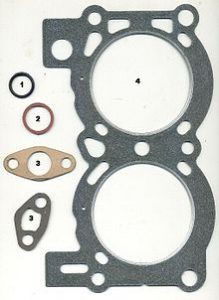 Gaskets are commonly used in a wide variety of manufactured goods and products. In the most basic sense, a gasket is a mechanical seal that’s designed to fill the voided space between two surfaces. When two objects are connected, there’s often a small but noticeable space between them. Depending on the specific function of the end product, this space could cause serious issues, such as air or water leakage.
Gaskets are commonly used in a wide variety of manufactured goods and products. In the most basic sense, a gasket is a mechanical seal that’s designed to fill the voided space between two surfaces. When two objects are connected, there’s often a small but noticeable space between them. Depending on the specific function of the end product, this space could cause serious issues, such as air or water leakage.
A common example of a gasket is the “head gasket” found on many modern-day automobile engines. A head gasket is a small, thin piece of metal (shown to the left) that’s placed between the engine block and cylinder heads. Like most gaskets, it’s designed to create an air-tight seal at the junction of these two surfaces, preventing liquid and gas from escaping. Gaskets are used in many other applications, however, typically to prevent leakage where two surfaces join.
Thankfully, gaskets prevent these and other problems by creating a tight seal where these surfaces meet. A car or vehicle with a faulty head gasket may leak cooling fluid or exhaust gases, which can subsequently cause the engine to overheat. Generally speaking, a faulty gasket leaks the fluid, gases or other elements that it’s designed to seal. After all, the fundamental purpose of a gasket is to create an air-tight seal at the junction where two surfaces meet.
Things to Consider When Choosing a Gasket:
- Arguably, the most important thing to consider when choosing a gasket is the material from which it is constructed. Common materials include rubber, silicone, cork, PTFE, steel and plastic polymer.
- Strength/durability is another factor to consider when choosing a gasket. Being that gaskets are designed to prevent air and/or liquid from escaping, they are typically under pressure. If the gasket is weak, the high pressure could damage or “blow” it, in which case the gasket will no longer serve its intended function.
- Do you need a single or double-jacket gasket? A double-jacket gasket is characterized by a specific design featuring a C-shaped tube that fits inside of a C-shaped tube.
- How long has the company selling the gasket been in business? With more than 40 years of experience, Monroe Engineering is a trusted and reputable vendor of gaskets and other manufacturing components.
Hopefully, this gives you a better understanding of gaskets and how they are used.
